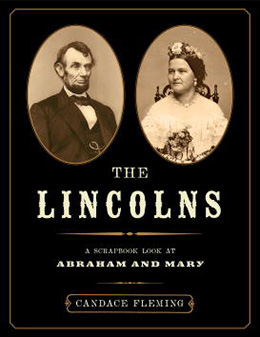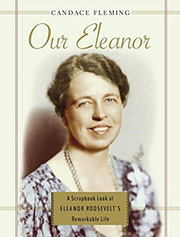BOOKS

Schwartz & Wade, 2008
978–0375836183
ages 9 and older
Find this book at your favorite used bookstore or public library.
After you’ve read The Lincolns, try this book:
The Lincolns
A Scrapbook Look at Abraham and Mary
Here are the extraordinary lives of Abraham and Mary, from their disparate childhoods and tumultuous courtship, through the agony of the Civil War, to the loss of three of their children, and finally their own tragic deaths.
Readers can find Mary’s recipe for Abraham’s favorite cake — and bake it themselves; hear what Abraham looked like as a toddler; see a photo of the Lincolns’ dog; discover that the Lincoln children kept goats at the White House; see the Emancipation Proclamation written in Lincoln’s own hand.
Perfect for reluctant readers as well as history lovers, The Lincolns provides a living breathing portrait of a man, a woman, and a country.
Candace Fleming, award-winning author of Ben Franklin’s Almanac and Our Eleanor, has created a biography of the Lincolns unlike any other — a scrapbook history that draws on photographs, letters, engravings, and even cartoons to form an enthralling museum on these pages.
Resources
- The Lincolns Educators Guide
- The Lincolns Educators Guide (one of The Books of Candace Fleming)
- View a page from the book
an excerpt from the author’s introduction
I’m an Illinois girl, raised in the very heart of the “land of Lincoln.” Growing up, I often bicycled out to the old Lincoln place — the farm Abraham and his parents settled when they moved to the state back in 1830. I thought nothing of clambering over the rotting log cabin or exploring the crumbling root cellar. Sometimes, I rode the extra half mile to the Shiloh Cemetery to eat peanut butter crackers while leaning against stepmother Sarah’s and father Tom’s headstones. Other times, I pedaled over to the fairgrounds where Lincoln once debated Stephen A. Douglas, or I rested on the cool, green grass of the county courthouse — the same place Abraham had practiced law when riding the Eighth Circuit. Occasionally, I spent the night at my friend Emily’s house. Lincoln had once slept in what later became her bedroom, and we often lay awake hoping to catch a glimpse of his ghost. Sometimes we asked our friend Karen to join us. Karen was a distant cousin of Lincoln, and I couldn’t help but wonder if sharing a pizza with her was like sharing one with our sixteenth president. then, of course, there was the annual field trip to Springfield; every October, my classmates and I boarded the school bus that would carry us along the Lincoln Heritage Trail to the state capital, some seventy miles away. Yet again, I traipsed through the Lincoln tomb. Encountering his bust outside the gravesite, I always rubbed his big bronze nose for good luck. At the Lincoln Souvenir Shop, I bought yet another stovepipe hat pencil sharpener. Then I climbed back on the bus and headed home, feeling as if I had just visited an old friend.
A few years ago, when my editor suggested I write a biography of Abraham Lincoln, I hesitated. Perhaps because Lincoln was so familiar to me, I’d never considered writing about him. Still, as I began reading books and articles, that old childhood feeling of connectedness began creeping over me. Suddenly, I longed to peel away the layers of myth and symbol and produce a close, intimate portrait of the man. More than anything, I wanted to reveal the real Abraham Lincoln. But how?
I dove into the wealth of Lincoln material — letters, diaries, newspapers — and encountered Mary. I admit I didn’t know much about his wife when I first began this project. Certainly, I’d heard stories about her extravagant spending sprees, her violent temper tantrums, her time in an insane asylum. Yet few people know the whole truth that for all her faults, Mary Lincoln was brilliant and restless, her life a string of tragedies, her spirit amazingly resilient. She and her husband were so inextricably found that a Springfield friend once said, “they were like two pine trees that had grown so close their roots were forever intertwined.”
Awards and Honors
- ALA Notable Books 2009
- Booklist Editors’ Choice
- Boston Globe Horn Book Award for Nonfiction 2009
- Flora Stieglitz Straus Award for Nonfiction 2009, Bank
- Street School of Education
- Horn Book Best Book
- IRA Teachers’ Choices
- Kirkus Reviews Best Book for Young Adults
- Los Angeles Times Literary Book Prize 2009, Finalist
- NCTE Orbis Pictus Honor Book
- New York Public Library 100 Titles for Reading and Sharing
- School Library Journal Best Book
Reviews
“Using the same innovative scrapbook format employed in Ben Franklin’s Almanac (2003) and Our Eleanor (2005), Fleming offers another standout biographical title, this time twining accounts of two lives — Abraham and Mary Todd Lincoln — into one fascinating whole. On spreads that combine well-chosen visuals with blocks of headlined text, Fleming gives a full, birth-to-death view of the “inextricably bound” Lincolns. Once again, Fleming humanizes her subjects and offers a broader perspective on their times with cleverly juxtaposed facts, anecdotes, and images. One page, for example, combines an 1861 map of the divided U.S. with detailed descriptions of what the new president and First Lady each tackled the day after Lincoln’s inauguration (Fort Sumter and securing a dressmaker, respectively). Although the reproductions are often small and dark, the intriguing visual mix will easily draw readers and browsers alike. Included are paintings and etchings of heartrending historical events, church documents, handwritten notes, and political cartoons. Fleming’s writing, filled with quotes and personal details, is just as lively as the assortment of images, and an extensive time line, suggested resources, and source notes round out the text. Starting with her personal introduction, this exemplary resource will prompt readers to consider how an individual’s life story, and a country’s history, are constructed. (Gillian Engberg, Booklist, starred review)
“What did this backwoods boy and this bluegrass girl have in common? Using her signature scrapbook approach, Fleming lays out the answer in a biography that gives equal emphasis to Abraham and Mary Lincoln for an insightful portrait of their lives. Her scholarship over five years pays off with a rich account that is personal and concrete. She recounts Mary’s early life as a privileged – but motherless – child, her ambitions for her husband, and her role as “first lady” (a term originally coined for her). Large and small details are juxtaposed with specifics about Lincoln and broadened by Mary’s significance. For example, a political decision was made regarding her attendance at the debates; Lincoln wanted to preserve his “common man” image rather than show off his refined and educated wife. Unlike most biographies, which conclude with Lincoln’s death, this one follows Mary’s story to the end, detailing Robert Todd’s role in her commitment to an insane asylum, Tad’s death, and her own demise. Presented in period typefaces, the boxed bits of text, sidebars, and numerous running heads and subheads add detail. From portraits to pets, the book contains a wide variety of graphics, including written and visual primary documents that enrich every spread. Notes, resources, and source notes are exemplary. It’s hard to imagine a more engaging or well-told biography of the Lincolns. (Janet S. Thompson, School Library Journal, starred review)
“Fleming’s five-year immersion in letters, diaries, newspapers, speeches and other primary documents yields a monumental visual chronicle of Abraham and Mary Lincoln and their times. The visuals range from the essential to the mundane — portraits, maps, battlefield scenes, political cartoons, dress patterns, a stovepipe hat and measurements for a pair of boots — and, along with clear writing and thematic organization, leave readers ‘feeling as if you have just visited old friends.’ Redressing a wrong committed by many histories for young readers, Mary Lincoln is portrayed here as a multidimensional woman of intelligence and social conscience, and the issue of slavery is clearly and concisely handled. The scrapbook technique, used previously in Our Eleanor (2005) and Ben Franklin’s Almanac (2003), remains fresh and lively, a great way to provide a huge amount of information in a format that invites both browsing and in-depth study. Extensive end notes round out an impressive volume. (Kirkus Reviews, starred review)
“Fleming has already applied her scrapbook approach to biographies of Benjamin Franklin and Eleanor Roosevelt; now she turns her attention to Abraham and Mary Lincoln. There are several clear advantages to this thematic, nonlinear treatment: the book is chock full of reproductions of primary sources, both textual and visual; it features an abundant supply of the sort of interesting anecdotes that are not so easily shoehorned into a more straightforward narrative; and it is equally inviting as reference material, casual browsing, or pleasure reading. Moreover, the dual biography is an inspired choice here. By giving Mary’s often neglected story equal weight, Fleming is able to compare and contrast the president with his first lady, giving us not only greater insight into each of them but also a fuller picture of the world in which they lived. ‘They were like two pine trees that had grown so close their roots were forever intertwined.’ They are also forever intertwined with the American story, a connection this excellent biography will reinforce for young readers.” (The Horn Book, starred review)


